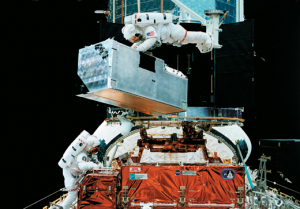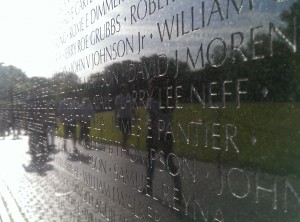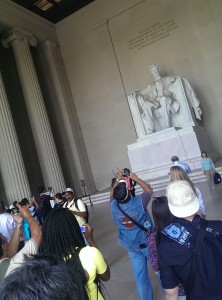
Shuttle astronauts prepare to install COSTAR during the first Hubble Space Telescope servicing mission in December 1993. (courtesy NASA)
After finishing up my moderating duties at Compliance Week 2014, I put on my running stuff and headed to the National Mall, destination National Air and Space Museum. The aim was to see something very specific, an instrument brought back from the Hubble Space Telescope during its final servicing mission in May 2009. In the book, I wrote about it and its creator, a Dutchman who had retired from Ball Aerospace in Boulder but returned to work on this instrument. The instrument compensated for the flaw in the Hubble’s primary mirror.
[Ball optics engineer Murk] Bottema spent his days on the Hubble problem, but his best hours were at night. After tea, reading the newspaper and a late dinner, he sat at the dining-room table with pencil and paper, writing equations. When things were going well, he whistled. When they went less well, he paced back and forth through the living and dining rooms. He talked through nettlesome technical details with his wife, who sewed on the couch under a window that looked out on the southerly portion of the Flatirons formation. She didn’t understand him, knew he was answering his own questions, and stitched away.
He designed a pair of mirrors on a telescoping arm. The first would reach out and snatch Hubble’s light before it could feed an instrument, redirecting it to a second mirror. The second mirror would be deformed in a way precisely opposite to the flaw of Hubble’s primary mirror but 200 times smaller. He solved the equations and showed that a few strategically placed mirrors could deliver corrected light to three Hubble instruments.
This work provided the basis for the Corrective Optics Space Telescope Axial Replacement, or COSTAR, which a team of about 400 workers built at Ball Aerospace, in a crash 28-month program. From Crocker’s vision in a German shower and Bottema’s optical mastery evolved a $50 million masterpiece of space hardware. Built into a spare Hubble instrument box the size of a voting booth, the business end of COSTAR would reach out into the body of the telescope itself. The optics package squeezed ten mirrors, four telescoping arms, a dozen electric motors and various heaters, wiring and sensors into a four-foot-long triangular prism with a cross section the size of a slice of apple pie.
COSTAR salvaged three other instruments, one which soon confirmed the presence of a supermassive black hole at the center of the Milky Way galaxy.
It was a couple of miles’ jog from the Mayflower Hotel down to the museum. I stopped off at the Washington Monument on the way. At the museum, I stood in a light sweat the security line, which moves fast enough that one wonders about its purpose. Past John Glenn’s capsule and Neil Armstrong’s/Buzz Aldrin’s/Michael Collins’s capsule, far below SpaceShipOne and Charles Lindberg’s Spirit of Saint Louis and Chuck Yeager’s Bell X-1 all dangling from the rafters, I asked a young guy at the information desk if he could tell me where COSTAR was.
He was enthusiastic, escorting me around the corner to the new display, between full-size Skylab and Hubble mockups. No matter how big you imagine Hubble to be, it’s bigger. And there COSTAR was, next to JPL’s Wide Field and Planetary Camera 2 (WFPC2), installed at the same time as COSTAR in 1993. These two boxes – OK, one box and one thing shaped more like a grand piano – circled the Earth for thirteen-and-a-half years, covering more than two billion miles in orbit. WFPC2’s radiator had been battered with micrometeorite hits, each drilled out, apparently for effect. COSTAR looked brand new. And there, extended and protected in somewhat haphazard looking clear plastic the shaped roughly like a coffee can, was its business end. I had only my phone and attempted to photograph it without much success. COSTAR is mostly a box with a protuberance like a robot-witch’s hand. Mostly I just took this thing in and wondered again how the hell Murk Bottema ever conceived of it.
And then it was back out to the mall on a gorgeous May afternoon, the gravel crunching underfoot with each landing. I had forgotten how these green spaces serve as sports fields for ultimate Frisbee and soccer practices, how many school groups can congregate here without getting in each others’ way. I heard a lot of Chinese. I walked as I approached the water-world World War II memorial, which I didn’t remember, perhaps due to its forgettablility. I found myself, as ever, chilled and moved by the indelible Vietnam memorial, the sunken delta that so elegantly demonstrates the real cost of dogmatic adherence to an abstract political theory. My eyes landed on the name Larry Lee Neff. The listings aren’t alphabetical. There are 58,286 names on the wall. Neff is not Smith.
He had been in Vietnam for about two months. He died in Quang Tri province on April 20, 1968, from “wounds to the body from hostile rifle fire while on patrol,” a few months before I was born. He had been born just 19 years before. He was a marine, private first class, hometown Danielsville, Penn., probably not far from where my dad’s dad was born, the land of the Pennsylvania Dutch. I see no resemblance in the photo, but the furrows of our DNA would probably say differently.
I moved on, walking some, jogging some, dodging tourists, up to the Lincoln Memorial, which I make a point of visiting whenever I find myself in the nation’s capital. The great man’s Gettysburg and second inaugural addresses somehow read better in stone. I pause always at the irony of the “The world will little note, nor long remember what we say here” bit. I read slowly, remarking at the rhetorical power squeezed into so few words. Like the optical power squeezed into cross-section the size of a slice of apple pie, refocusing the vision – of Founding Fathers and the great space telescope – in their times of greatest need.






12 Comments
Rev. Bob Matros liked this on Facebook.
Shinichiro Takagi liked this on Facebook.
Amazing read!!!
Last time I was in DC, my wife and I were walking the monuments with Frtz Baetz and his wife at night. The monuments task on a different character at night, and the Wall, Lincoln and MLK seem to become more like hallowed ground.
Dave Hinchman liked this on Facebook.
Dave Allen liked this on Facebook.
Wendy Anderson Hutto liked this on Facebook.
Wendy, sorry to miss you and Chase and the little ones this time. Dave, I didn’t know Fritz was in DC. It’s a remarkable place, the Mall.
Michael Gershowitz liked this on Facebook.
Great post, especially the part about Compliance Week.
-Matt Kelly, editor, Compliance Week
Heike Lang liked this on Facebook.
Andris Berzins liked this on Facebook.
Comments are closed.